If you’re new to rock climbing, it’s likely that you’ve heard some rock climbing terminology thrown around that left you a bit confused. Whether you’re venturing out at a climbing gym or a local crag, rock climbing is an intensely engaging sport with highly technical jargon.
View in gallery
A heightened interest in the sport in recent years has brought new climbers who are enthusiastic to learn the sport but are clueless, and often frustrated when it comes to mastering rock climbing terminology.
Let’s ease the burden by explaining some of the lingo commonly used by rock climbers.
Common Rock Climbing Terminology Explained
Rock climbing being a team sport, you need to have a grasp of the basic lingo to be able to seamlessly (and safely) communicate with other climbers. Typical of any sport or subculture, rock climbing has its fair share of vocabulary that may seem intimidating at first.
Here are the basic climbing terms to get you going, in alphabetical order:
1. Anchor
A device that attaches the rope to the climbing surface such as rock or ice. It’s that point where the rope supporting the climber is attached to the climbing surface for safety. It can be at the end of the route, or midway through the route, or at the base of the climbing problem to hold a belayer. The anchor device may consist of bolts, slings, ropes, chains, and so forth.
2. Approach
The way or path to the foot of the climb where the actual climb commences. Could be a walk, run, or a scramble to the climb. Approach shoes are ideal for this stage, whereas you’ll want to change into climbing shoes once you’re at the base of the climb.
3. Arete
An acute-angle edge or ridge on a cliff, boulder, or mountain similar to a corner on a building.
4. Auto-lock
A system that automatically locks securely without the need to lock it up manually. Refers to carabiners that have this safety feature that allows them to lock on their own after they’ve been opened.
5. Bouldering
View in gallery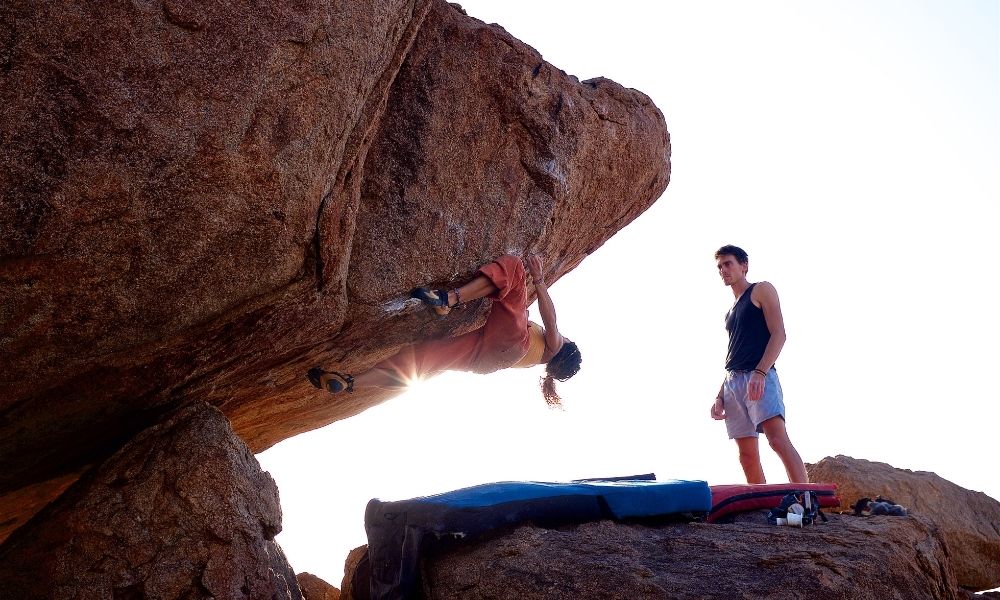
Bouldering is the simplest and most common form of climbing. Here, no ropes are used. You’ll need shoes, chalk, and crash pads for safety. The climbing is typically on short, low lying routes, ideally no higher than 15 feet off the ground. It typically involves climbing at the base of hills or on boulders.
Initially, it was used as a preliminary to rope climbing, but it has now taken a life of its own as a popular sport in its own right. Whereas rope climbing tests your endurance, bouldering is a test of power and overall fitness. It’s all about making tough maneuvers over short routes.
6. Bouldering Pads
A bouldering pad, also known as a crash pad, is a dense foam pad for protection when bouldering. It’s placed below the boulder to cushion against injury in case of a fall. Bouldering pads come in a variety of shapes and sizes; and for portability, they can be folded and strapped like a backpack.
7. Beta
A progressive description of a route or a climb, provided either verbally by a climber or in the form of a guidebook.
8. Belay
Belaying is a technique climbers use to secure the rope as a teammate climbs. You use this technique to provide friction to the rope system such that the device locks and supports your partner. A belaying device controls the rope to stop a climber from falling over the cliff to the ground in the event they slip off. You’ll need an anchor, a rope, a belay device, and a belayer to deploy a belay system.
A belay device limits the distance a climber could fall off a rock face. It works by locking the rope to “catch” a falling climber. A belayer is a partner who controls the climbing rope that’s fastened to the climber to protect them in case they fall.
9. Barndoor
Barndoor means that the climber is unbalanced, has lost their footing, and is swinging off the rock. When the climber loses footing, the body begins to swing much like a barn door. If not careful on overhanging terrain, the barn door effect can lead to a fall.
10. Bolt
A permanently anchored metal that’s been drilled into the rock for safety, primarily found on sport climbing routes. They offer extreme protection as they consist of self-anchoring bolts that expand in the rock. A climber clips quickdraws to the bolts and passes a rope through the anchor for support.
11. Bolted Route
A sport climbing route that features permanently fixed bolts fixed to rock walls is referred to as a bolted route. The bolts provide anchorage for clipping in quickdraws that in turn have a climbing rope clipped to them.
12. Bomb-proof
A route considered to be highly safe due to the presence of one or more crucial anchors.
13. Cam
A spring-loaded mechanical device that offers protection to climbers. It fits into crevices in a rock face and secures the portion of rope to that section of the wall should the climber fall.
14. Carabiner
View in gallery
A piece of metal that acts as a linking device that connects your rope and protection equipment to hardware in the wall.
15. Camming Device
A device used on a trad climbing route for the safety of the climber so that if they fall, they don’t fall far.
16. Chalk Bag
View in gallery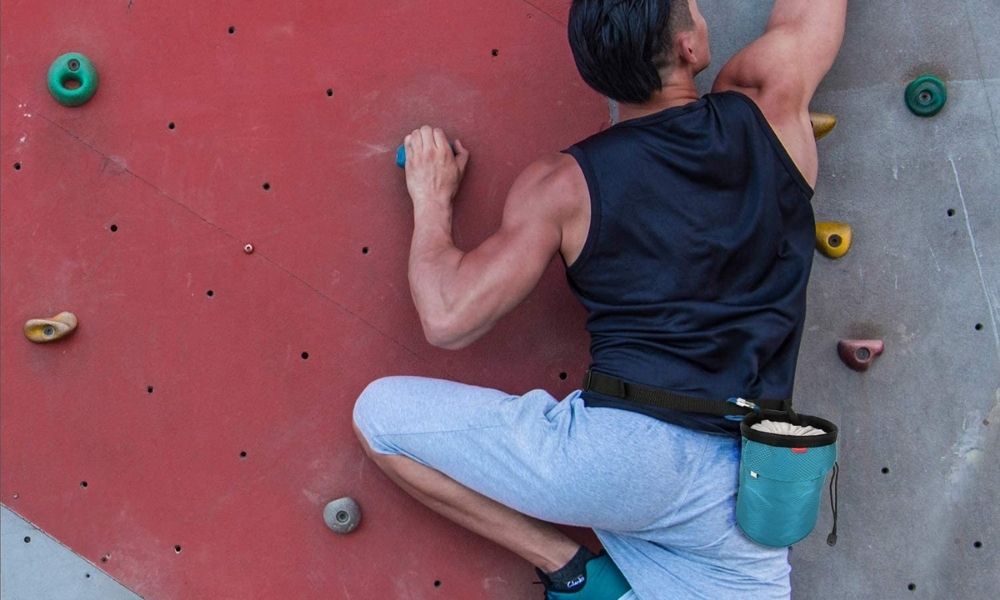
A small bag in which you place climbing chalk to improve the grip on your hands. Chalk keeps hands dry and increases friction for a better grasp. A chalk bag is worn on the waist belt or clipped to a climbing harness.
17. Chimney
View in gallery
Fissures found on rock walls that are sufficiently wide to fit your body into. A climber propels upwards in a chimney by applying opposing force with arms, legs, and back against either wall of the chimney.
18. Clean
The act of removing all the protection that was anchored onto the route by the lead climber. The climber behind the lead climber cleans the routes they ascend or on their way back down.
19. Crag
The term refers to an outdoor area where climbing takes place. It could be a small cliff or a boulder.
20. Crimp
Refers both to a type of hold, as well as the grip required for the hold. Crimp holds are typically extremely narrow and thin. This type of grip is an essential technique for rock climbing, but requires proper execution due to the extreme force loads on your finger joints and tendons.
21. Crux
The most challenging section of a climb. It can manifest anywhere along the climbing route.
22. Dynamic Rope
An elastic rope made from a special material for climbing purposes. The elasticity is what makes the rope dynamic. By stretching out slightly it takes in some of the impacts whenever a climber falls.
23. Dyno
A “leap of faith” of sorts where the climber moves dynamically between two surfaces. The climber lunges to the next surface and will at some point be touching no rock surface at all before landing at the climbing destination.
24. Edging
View in gallery
A technique where you place your weight on a tiny foothold using the edge of your shoe; particularly the toe and the frontal part of the shoes. Allows you to grasp overhanging terrain as you push up.
25. Figure of 8 Knot
A figure of 8 knot is simple to make but highly secure. It secures the climber and tightens as it takes the weight of the climber. Knot forms a shape resembling the number 8.
26. Fist Jam
A climbing method used in places where there are cracks just wide enough for your feet or fist to fit into. Jamming may be uncomfortable to the limbs, but sometimes it’s the only feasible way up during crack climbing.
27. Flash
When you complete a pitch on a route on the first attempt without falling, as a result of some beta or previous knowledge of the route.
28. Free Climbing
Free climbing is the opposite of aid climbing, where a climber relies on gear for support as they move upwards. As a free climber, you propel yourself upwards with your own strength and technique without relying on climbing aids or tools, such as ladders, aiders, skyhooks, or ascenders are not employed.
Free climbing does use some type of gear such as ropes, bolts, and cams for protection in case of a fall. However, the gear does not directly aid the climber move up the object. Types of free climbing include sport climbing, top-roping, and trad climbing. In each of these, the climber uses gear that offers protection but does not aid the climber with their climbing.
29. Free Soloing
View in gallery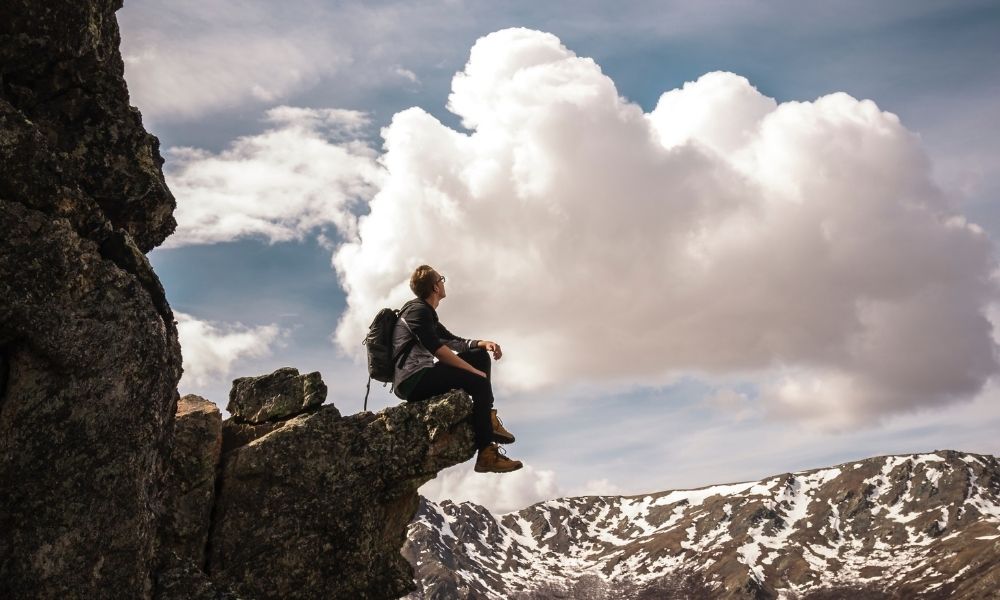
One of the most common mistakes climbing newbies make is confusing free climbing with solo climbing. Solo climbing can be free or aided.
Free soloing is a type of free climbing where you climb up by your own strength and skills without using climbing aids or protective gear. You do it “solo” without a partner, and you do not have safeguards like ropes, bolts, trad gear to catch you should you slip and fall. It’s generally considered quite dangerous, and not recommended for anyone who isn’t 110% confident in their abilities.
Some who attempt free solos prefer a “deep water solo”, where they climb against the backdrop of a deepwater body that they can plunge into should they lose their footing. The water will provide a safer, softer landing during such an eventuality. Since this type of climb is rather dangerous, solo-climbers choose easier routes and rehearse multiple times on softer targets before embarking on a major climb.
Alex Honnold and Dean Potter, are a few of those who’ve made for themselves a name on this dangerous terrain.
30. Gaston
A powerful ascension technique in which you are pushing outward with your arms, rather than pulling yourself up. Performed palms out, thumbs down. Named after Gaston Rébuffat, French climber, alpinist, and author.
31. Hand Jam
A smaller crack where only a hand can fit; as opposed to a fist jam, which is wide enough to even accommodate feet.
32. Harness
View in gallery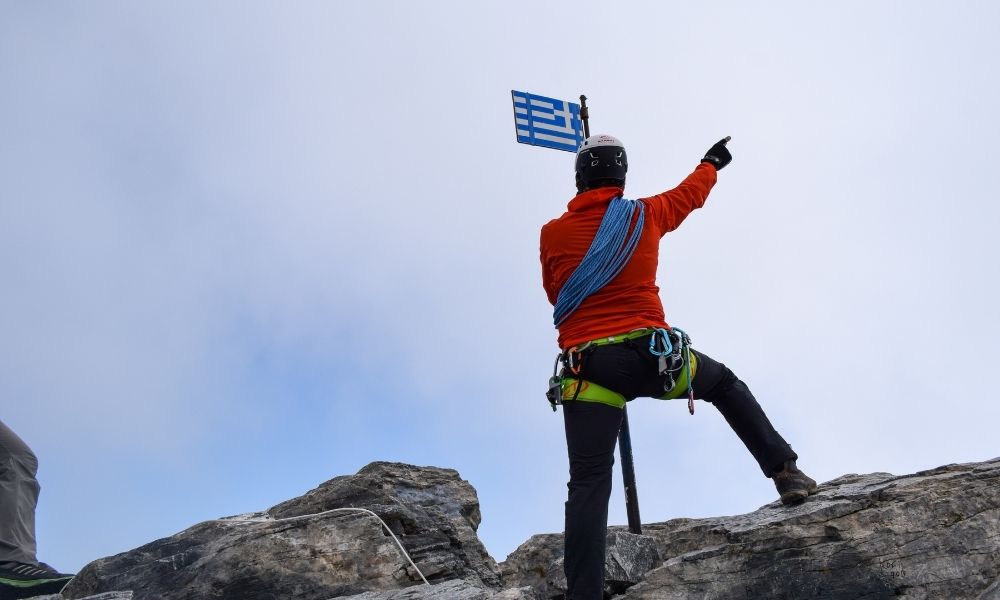
A robust belt attached to the rope and gives protection as you climb. The harness features a strong buckle and leg loops. Once worn, climbers tie themselves to the rope with a figure 8 knot. Besides climbers, belayers also need to put on a harness.
33. Heel Hook
A technique mostly used on an overhanging rock, where you use the heel to hook to the edge for stability on the rock as you climb.
34. Jug
View in gallery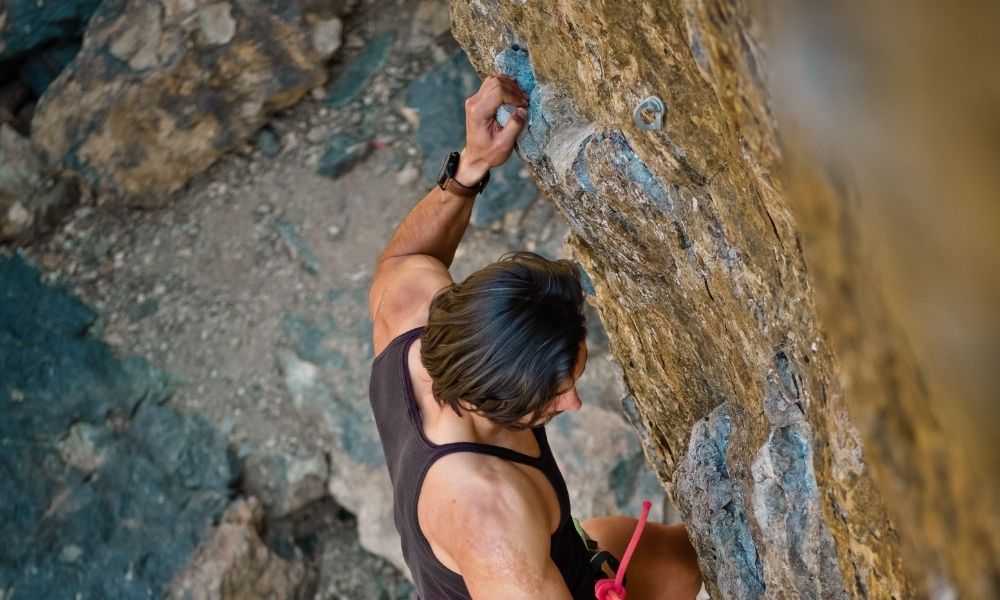
A sizable handhold that’s easy to grip. This is every climber’s best friend, as it allows firm, confident grips.
35. Lead Climbing
In this climbing technique, one person leads the pack of climbers on a route. They lead by placing gear on the climbing surface in trad climbing, or by hooking onto permanently fixed bolts in sport climbing.
36. Multipitch
Multipitch is a route that requires more than the length of one rope. The lead climber gets to the top of the pitch and belays the follower to his position. The rope is then used to move upwards to a second pitch. The leader moves up, anchors at the top of the second pitch, and belays the follower.
If only one climber is involved in a multipitch, they’ll climb to the end of the first pitch. They will then pull up the rope to their midway position and initiate another pitch. They’ll do this successively until they clear the route.
37. Passive protection
Passive protection is any climbing protection device with no moving parts. This includes stoppers, hexentrics, tricams, chocks, nuts, and other wedge-like devices that go into cracks and crevices.
38. Pitch
A route a climber can cover with the length of a single climbing rope.
39. Pocket
A hollow rock or hole that so tiny, only a finger or two can fit in.
40. Protection
Devices that minimize the dangers one is prone to while climbing. Also provides protection to others while you ascend. These are usually devices fixed into the rock surface so that a climber doesn’t fall far off if they slip from the rock. Examples include items such as bolts, nylon webbing, and cams.
41. Quickdraw
Quickdraws are also known as extenders. They’re used by lead climbers to link the rope to protection devices by clipping it to a bolt or protection. It consists of two carabiners attached by a reinforced textile sling. When used properly, quickdraws enable the climber to attain fluid movement by keeping the path of ropes straight, thus reducing friction.
42. Rack
A collective term that refers to the gear required by climbers for support and safety during a route climb.
43. Redpoint
When a climber goes over a route without falling from beginning to end, after practicing the route several times. Coined at Frankenjura by Kurt Albert in the mid 70’s, where he’d put a red X on spots as a visual reminder to avoid using them as handholds or footholds.
44. Runout
Describes the distance between a climber and their protection gear (such as bolts). A long-runout implies that the protection is too far off, leading the climber to feel less comfortable leaving the rock face for risk of falling big.
45. Send
You’ll mostly hear climbers use the word “sending”. To “send” means you climb through the entire route without taking a rest from start to finish. The next time some member of the climbing community shouts out to you, “send it”, know they’re asking you to put your best foot forward all the way up.
46. Sport Climbing
View in gallery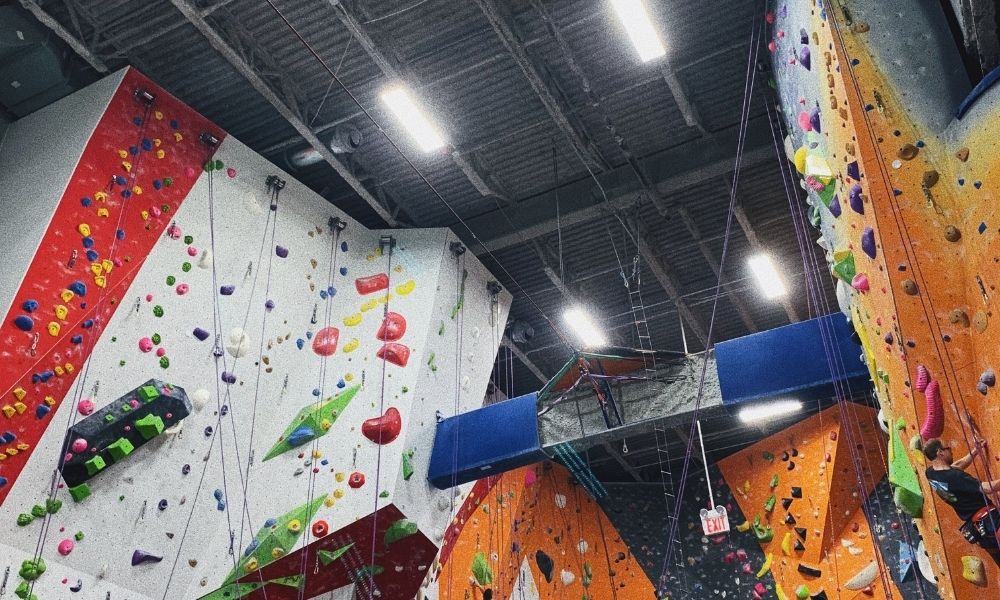
Rock climbing featuring permanently fixed protection devices that are affixed to the rock for safety during ascent. Usually consists of permanently drilled-in bolts. The rope that the climber uses is hooked to these anchors to protect him from falling over. Sport climbing may also entail climbing shorter routes with crash pads beneath for the safety of climbers.
47. Trad Climbing
Unlike sport climbing, in traditional climbing, the protection devices are not permanently anchored into the rock surface. You create protection with your gear as you climb and remove it all once the pitch is done. Trad climbing limits damage to the environment as the gear is removed after the route has been completed.
48. Top Out
Topping out is when you’ve reached the top of your climbing problem, then walk down the foot of the climb on trails, rather than by rappelling down on the climbing rope.
49. Off-width
An off-width crack is one too narrow for your torso or legs to fit into, yet too wide to accommodate your fist.
50. On-sight
Happens where a climber ascends up a route from start to finish without falling, having had no prior information about the site. As there is a lot of information regarding climbing challenges in guidebooks or on the net, it can be difficult to go into completely blind.
It can happen if the pack is the first to ever scale a particular rock face, mountain, or cliff, or if climbing was picking at random. If the climbers also got lost and landed at a wrong climbing base, there’s a chance of an on-sight.
Final Word
These terms may seem too many and overwhelming especially if you’re a beginner. But don’t fret, you’ll master each of them step by step as you continue interacting with other climbers. So send it!




